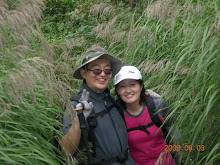Gwangneung Forest is expected to be listed as a world biosphere reserve by UNESCO.
The 25,000-hectare forest which stretches over three major cities in Gyeonggi Province has been preserved by the government for many years.
Once registered, Gwangneung will be protected through UNESCO's integrated management system and its ecosystem will be closely monitored by the organization.
The official announcement is set to be made during a meeting in Paris in June.
Gwangneung (光陵 광릉)
 It is the royal tomb of the 7th King Sejo (世祖, 세조 1417-1468) of the Joseon Dynasty and Queen Jeonghui (貞熹王后, 정희왕후 1418-1483) from the Yun family. The Gwangneung was well protected during the entire Joseon Dynasty by prohibiting even the removal of a mere tuft of grass. Today, it is a paradise for animals and plants and a natural museum of the habitat. King Sejo was the second son of King Sejong and was installed as Prince Suyang in 1415. Having great ambition for power, King Sejo raised a revolt, the Gyeyujeongnan (癸酉靖難, 계유정난) in 1452 after the enthronement of King Danjong. With this revolt, he seized power and King Danjong relinquished the throne in 1455.
It is the royal tomb of the 7th King Sejo (世祖, 세조 1417-1468) of the Joseon Dynasty and Queen Jeonghui (貞熹王后, 정희왕후 1418-1483) from the Yun family. The Gwangneung was well protected during the entire Joseon Dynasty by prohibiting even the removal of a mere tuft of grass. Today, it is a paradise for animals and plants and a natural museum of the habitat. King Sejo was the second son of King Sejong and was installed as Prince Suyang in 1415. Having great ambition for power, King Sejo raised a revolt, the Gyeyujeongnan (癸酉靖難, 계유정난) in 1452 after the enthronement of King Danjong. With this revolt, he seized power and King Danjong relinquished the throne in 1455. Even though King Sejo usurped the throne, he was responsible for many brilliant achievements by improving the entire national system: externally, he strengthened national power and made two conquests of the northern tribe, Jurchen. Internally, he compiled the Gyeonggukdaejeon (經國大典, 경국대전, Grand Code for State Administration).
Queen Jeonghui was the mother of King Deokjong (德宗, 덕종) and King Yejong (睿宗, 예종). When King Deokjong died young and King Yejong ascended the throne at the young age of 14, Queen Jeonghui ruled as regent for the first time in the history of the Joseon Dynasty. When King Yejong passed away after just one year of his reign, she raised Prince Jasan (King Seongjong), the son of King Deokjong, to the throne. As King Seongjong also ascended the throne at the tender age of 13, Queen Jeonghui ruled as regent again for seven years. She was a woman of strong character, as seen from the episode of encouraging King Sejo during the Gyeyujeongnan and her two regencies.
Hwigyeongwon (徽慶園, 휘경원)
This is the tomb of the royal concubine Subin (綬嬪, 수빈 1770-1822) from the Bak family. She was a royal concubine of the 22nd King Jeongjo of the Joseon Dynasty. Subin, from the Bak family, delivered Prince Sunjo in 1790. She was gentle, well-behaved and courteous. She was also usually taciturn and lived simply. As a result, she was greatly admired as “a benevolent wife (賢嬪, 현빈)”. In 1855 (the 6th year of King Cheoljong), when the Illeung, the royal tomb of King Sunjo, was moved to another location, the hwigyeongwon was moved to the Sungangwon. In the 14th year of King Cheoljong, it was moved again to the current place because the location of the Sungangwon was reportedly not good, according to the Feng Shui. The ancestral tablet is enshrined in the Chilgung (the place where ancestral tablets of seven royal concubines are enshrined. All of them were birth mothers of kings of the Joseon Dynasty or those who received the posthumous title of king). She received a posthumous title of Subi (綏妃, 수비) in the 5th year of the Gwangmu (1901).
Yeongbinmyo (寧嬪墓)
This is the tomb of the royal concubine Yeongbin (寧嬪, 영빈 1669-1735) from the Gim family. She was a royal concubine of the 19th King Sukjong of the Joseon Dynasty. When Queen Inhyeon was dethroned by Janghuibin (concubine from the Jang family), Yeongbin was also evicted to her maiden home. When Queen Inhyeon was restored, she returned to the palace with the queen. Around the tomb of Yeongbin, several stone figures can be seen standing to show her sincere respect. On the gravestone standing in front of the mound, a history of Yeongbin’s life is carved in detail.




No comments:
Post a Comment